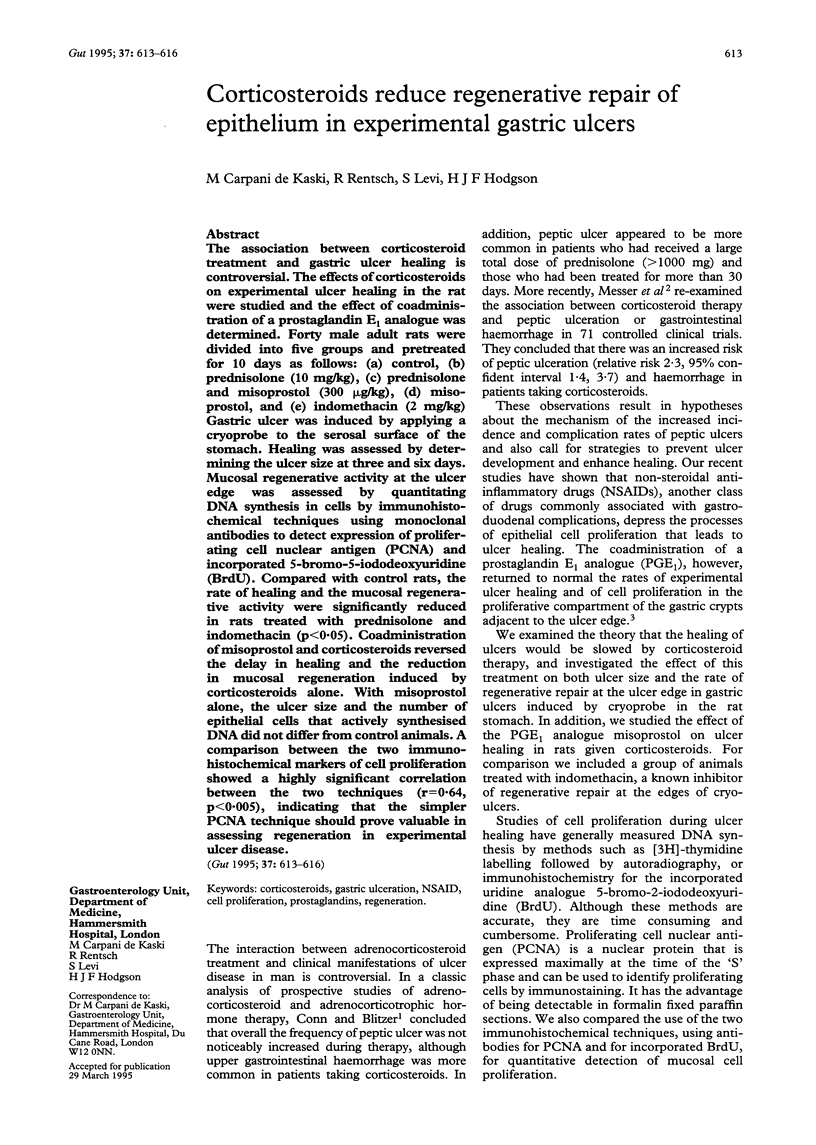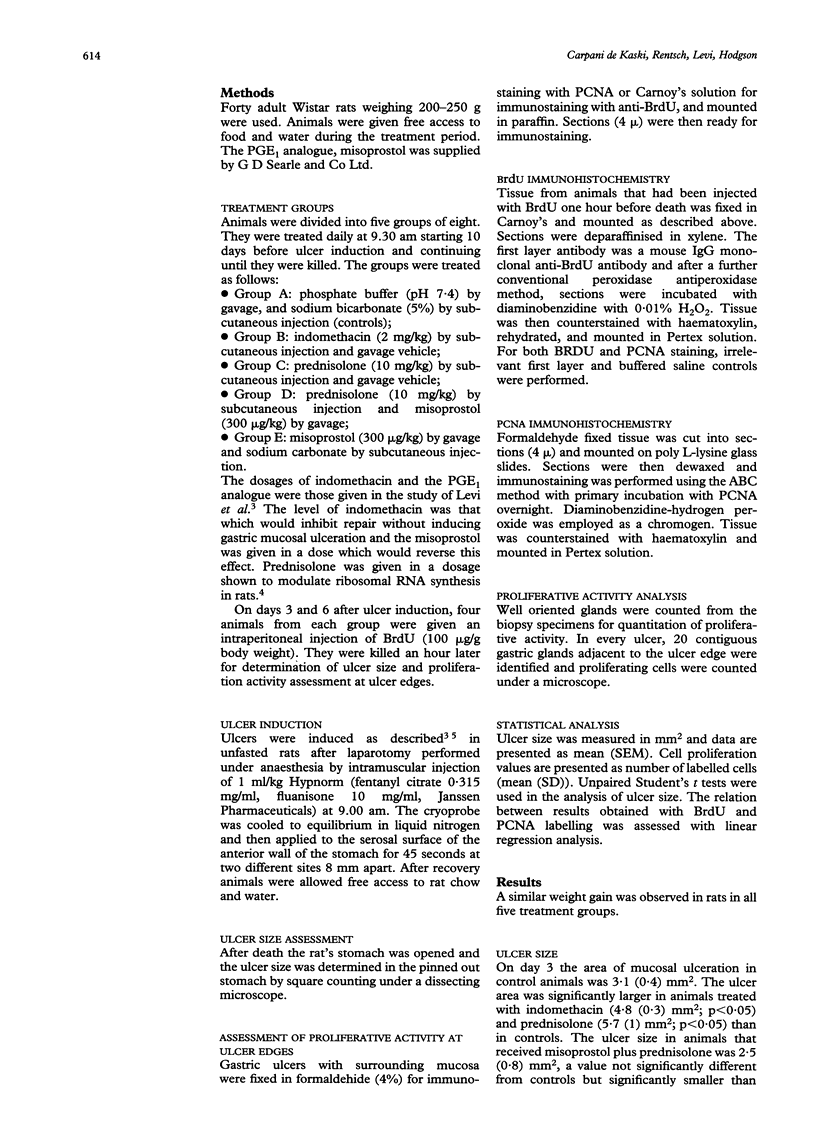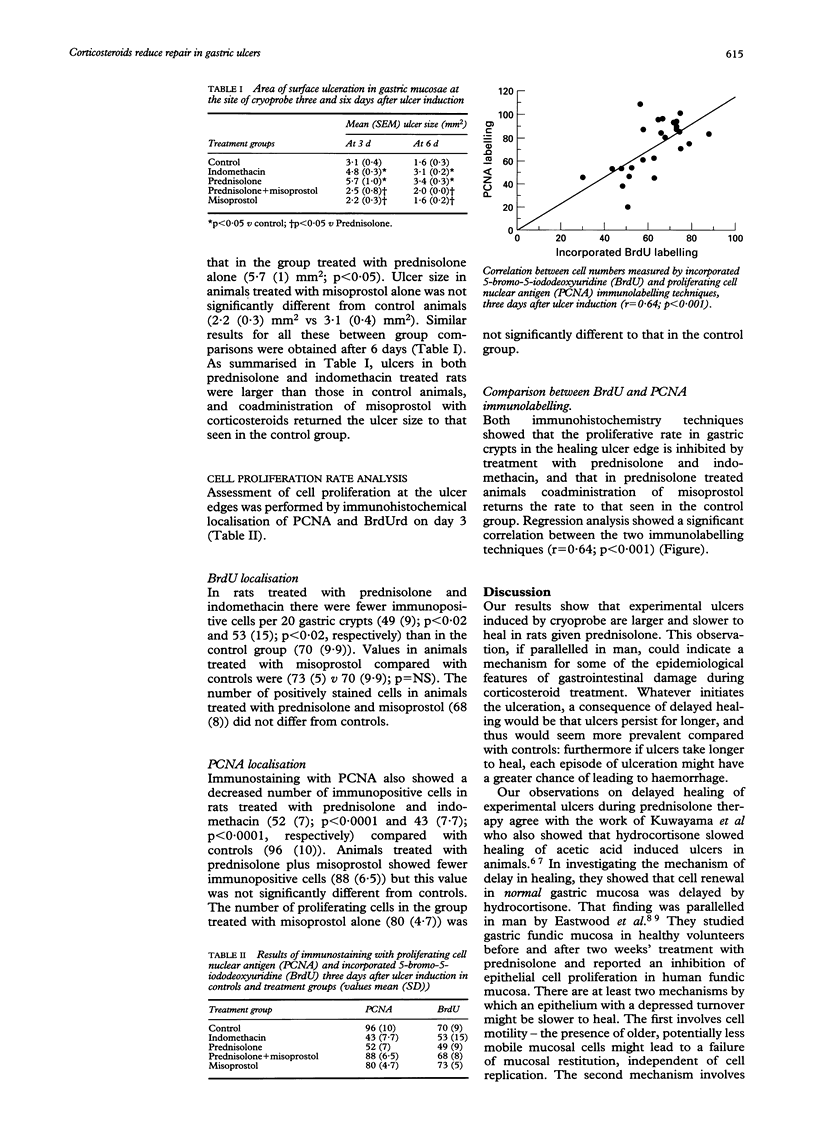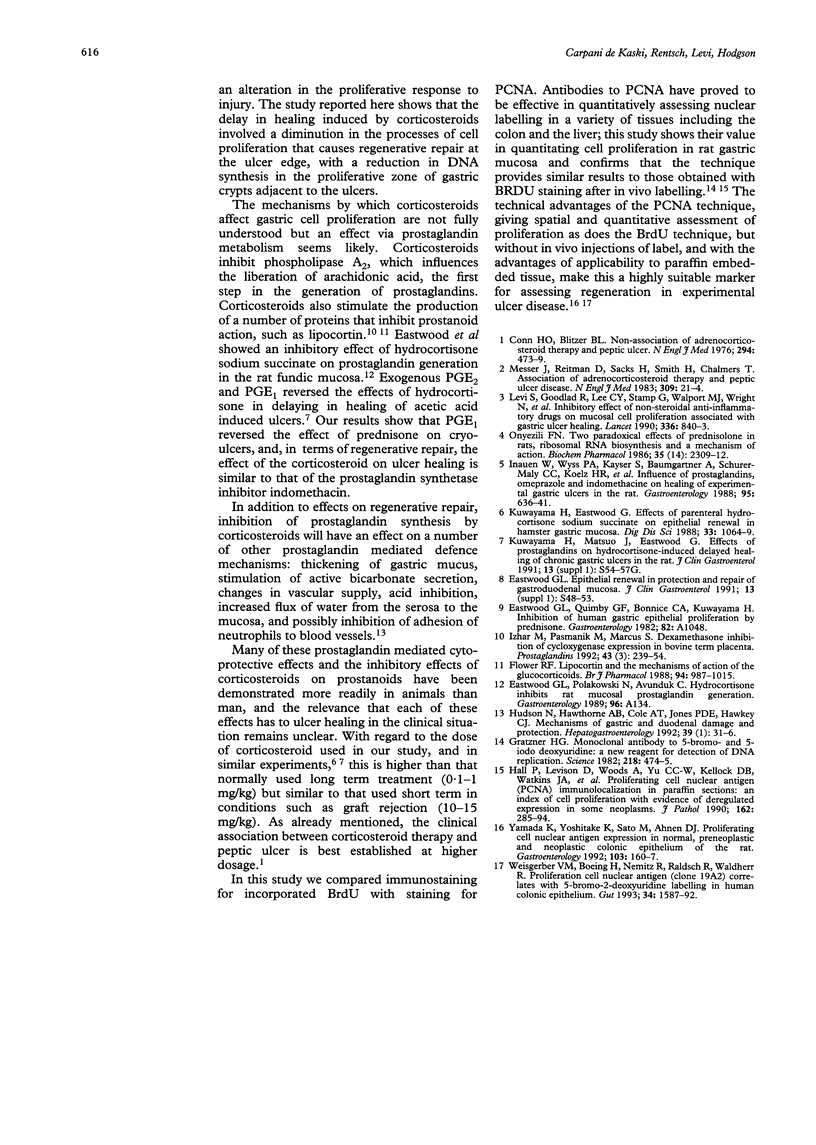Abstract
The association between corticosteroid treatment and gastric ulcer healing is controversial. The effects of corticosteroids on experimental ulcer healing in the rat were studied and the effect of coadministration of a prostaglandin E1 analogue was determined. Forty male adult rats were divided into five groups and pretreated for 10 days as follows: (a) control, (b) prednisolone (10 mg/kg), (c) prednisolone and misoprostol (300 micrograms/kg), (d) misoprostol, and (e) indomethacin (2 mg/kg) Gastric ulcer was induced by applying a cryoprobe to the serosal surface of the stomach. Healing was assessed by determining the ulcer size at three and six days. Mucosal regenerative activity at the ulcer edge was assessed by quantitating DNA synthesis in cells by immunohistochemical techniques using monoclonal antibodies to detect expression of proliferating cell nuclear antigen (PCNA) and incorporated 5-bromo-5-iododeoxyuridine (BrdU). Compared with control rats, the rate of healing and the mucosal regenerative activity were significantly reduced in rats treated with prednisolone and indomethacin (p < 0.05). Coadministration of misoprostol and corticosteroids reversed the delay in healing and the reduction in mucosal regeneration induced by corticosteroids alone. With misoprostol alone, the ulcer size and the number of epithelial cells that actively synthesised DNA did not differ from control animals. A comparison between the two immunohistochemical markers of cell proliferation showed a highly significant correlation between the two techniques (r = 0.64, p < 0.005), indicating that the simpler PCNA technique should prove valuable in assessing regeneration in experimental ulcer disease.
Full text
PDF



Selected References
These references are in PubMed. This may not be the complete list of references from this article.
- Conn H. O., Blitzer B. L. Nonassociation of adrenocorticosteroid therapy and peptic ulcer. N Engl J Med. 1976 Feb 26;294(9):473–479. doi: 10.1056/NEJM197602262940905. [DOI] [PubMed] [Google Scholar]
- Eastwood G. L. Epithelial renewal in protection and repair of gastroduodenal mucosa. J Clin Gastroenterol. 1991;13 (Suppl 1):S48–S53. doi: 10.1097/00004836-199112001-00008. [DOI] [PubMed] [Google Scholar]
- Flower R. J. Eleventh Gaddum memorial lecture. Lipocortin and the mechanism of action of the glucocorticoids. Br J Pharmacol. 1988 Aug;94(4):987–1015. doi: 10.1111/j.1476-5381.1988.tb11614.x. [DOI] [PMC free article] [PubMed] [Google Scholar]
- Gratzner H. G. Monoclonal antibody to 5-bromo- and 5-iododeoxyuridine: A new reagent for detection of DNA replication. Science. 1982 Oct 29;218(4571):474–475. doi: 10.1126/science.7123245. [DOI] [PubMed] [Google Scholar]
- Hall P. A., Levison D. A., Woods A. L., Yu C. C., Kellock D. B., Watkins J. A., Barnes D. M., Gillett C. E., Camplejohn R., Dover R. Proliferating cell nuclear antigen (PCNA) immunolocalization in paraffin sections: an index of cell proliferation with evidence of deregulated expression in some neoplasms. J Pathol. 1990 Dec;162(4):285–294. doi: 10.1002/path.1711620403. [DOI] [PubMed] [Google Scholar]
- Hudson N., Hawthorne A. B., Cole A. T., Jones P. D., Hawkey C. J. Mechanisms of gastric and duodenal damage and protection. Hepatogastroenterology. 1992 Feb;39 (Suppl 1):31–36. [PubMed] [Google Scholar]
- Inauen W., Wyss P. A., Kayser S., Baumgartner A., Schürer-Maly C. C., Koelz H. R., Halter F. Influence of prostaglandins, omeprazole, and indomethacin on healing of experimental gastric ulcers in the rat. Gastroenterology. 1988 Sep;95(3):636–641. doi: 10.1016/s0016-5085(88)80009-x. [DOI] [PubMed] [Google Scholar]
- Izhar M., Pasmanik M., Marcus S., Shemesh M. Dexamethasone inhibition of cyclooxygenase expression in bovine term placenta. Prostaglandins. 1992 Mar;43(3):239–254. doi: 10.1016/0090-6980(92)90092-8. [DOI] [PubMed] [Google Scholar]
- Kuwayama H., Eastwood G. L. Effects of parenteral hydrocortisone sodium succinate on epithelial renewal in hamster gastric mucosa. Dig Dis Sci. 1988 Sep;33(9):1064–1069. doi: 10.1007/BF01535779. [DOI] [PubMed] [Google Scholar]
- Kuwayama H., Matsuo Y., Eastwood G. L. Effects of prostaglandins on hydrocortisone-induced delayed healing of chronic gastric ulcers in the rat. J Clin Gastroenterol. 1991;13 (Suppl 1):S54–S57. doi: 10.1097/00004836-199112001-00009. [DOI] [PubMed] [Google Scholar]
- Levi S., Goodlad R. A., Lee C. Y., Stamp G., Walport M. J., Wright N. A., Hodgson H. J. Inhibitory effect of non-steroidal anti-inflammatory drugs on mucosal cell proliferation associated with gastric ulcer healing. Lancet. 1990 Oct 6;336(8719):840–843. doi: 10.1016/0140-6736(90)92341-e. [DOI] [PubMed] [Google Scholar]
- Messer J., Reitman D., Sacks H. S., Smith H., Jr, Chalmers T. C. Association of adrenocorticosteroid therapy and peptic-ulcer disease. N Engl J Med. 1983 Jul 7;309(1):21–24. doi: 10.1056/NEJM198307073090105. [DOI] [PubMed] [Google Scholar]
- Onyezili F. N. On two paradoxical side-effects of prednisolone in rats, ribosomal RNA biosyntheses, and a mechanism of action. Biochem Pharmacol. 1986 Jul 15;35(14):2309–2312. doi: 10.1016/0006-2952(86)90456-9. [DOI] [PubMed] [Google Scholar]
- Weisgerber U. M., Boeing H., Nemitz R., Raedsch R., Waldherr R. Proliferation cell nuclear antigen (clone 19A2) correlates with 5-bromo-2-deoxyuridine labelling in human colonic epithelium. Gut. 1993 Nov;34(11):1587–1592. doi: 10.1136/gut.34.11.1587. [DOI] [PMC free article] [PubMed] [Google Scholar]
- Yamada K., Yoshitake K., Sato M., Ahnen D. J. Proliferating cell nuclear antigen expression in normal, preneoplastic, and neoplastic colonic epithelium of the rat. Gastroenterology. 1992 Jul;103(1):160–167. doi: 10.1016/0016-5085(92)91109-h. [DOI] [PubMed] [Google Scholar]


